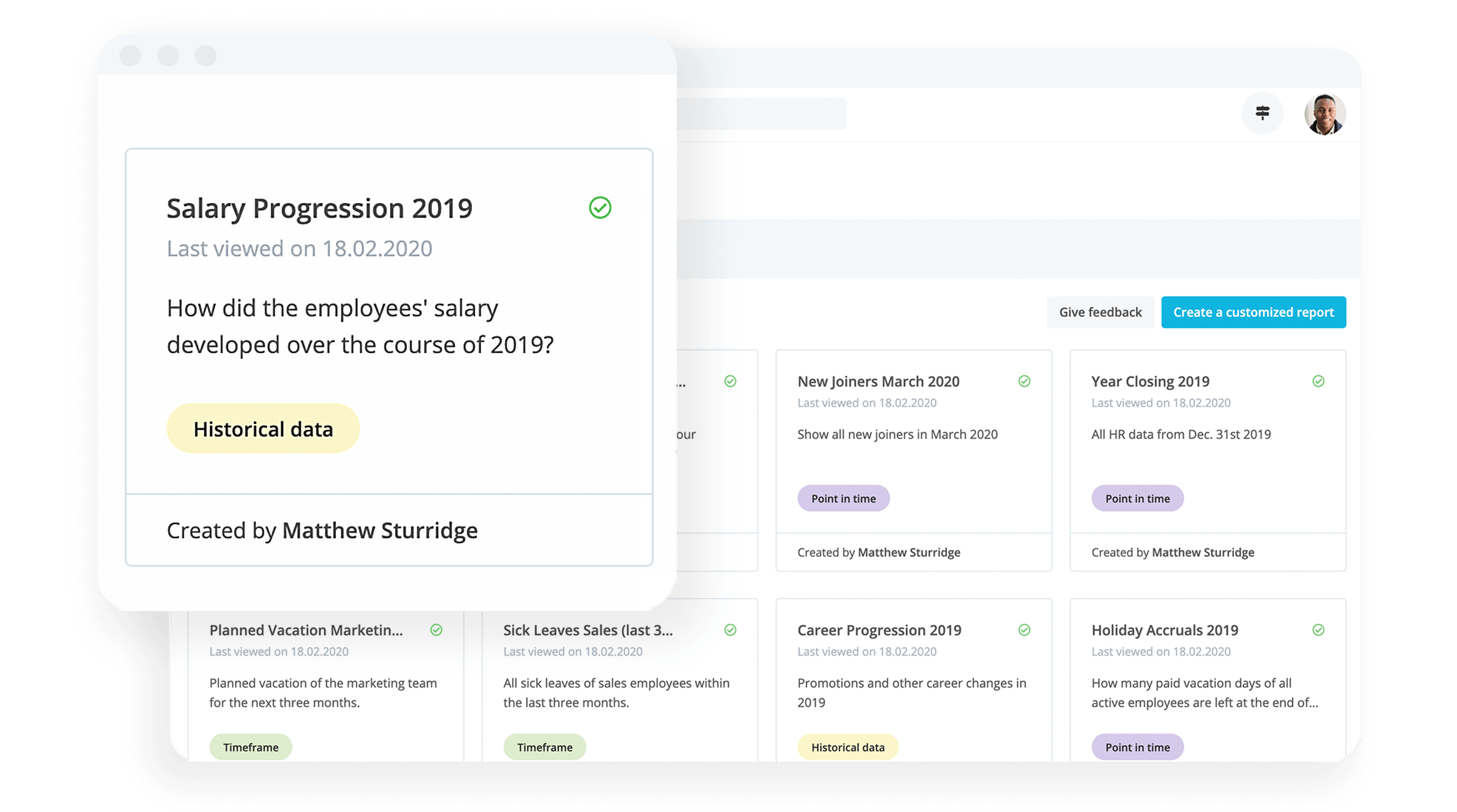5 Workforce Planning Tools Every HR Team Needs

The beauty behind using workplace planning tools is that they enable your HR team to plan around your current workforce while looking ahead to your future one. In this article, we offer a rundown of the five key tools that can help drive workplace planning success.
Workforce planning can help power your HR business plan. So can our handy template.What are workforce planning tools?
Workforce planning tools are a set of tools that help analyse the current abilities of your workforce and your future needs. They are designed to offer a more data-focused mindset in your people planning programmes like hiring, performance and others.
Do you need workforce planning tools?
The purpose of workforce planning tools is that they can help offset some of the uncertainty surrounding workforce planning. That’s because they serve as an attempt to bridge the gap between where your workforce currently stands and where it can go.
The 5 most common workforce planning tools
What are some of the most common workforce planning tools that people teams use? The following are the most common workforce planning tools to help build stronger processes. Here they are at a glance, followed by a deep dive into each:
Tool | Definition |
|---|---|
Organisational strategy | Your organisation’s top-line strategy, usually set out by the management team, is the best tool your HR team can have at its disposal. |
The 9-box grid | A tool used to map the current state of your workforce across the lines of performance and potential. |
HR analytics and reporting | An HR software with a proper analytics and reporting platform will help bring data to all your decisions. |
Total compensation and benefits analysis | Essentially a way to distill the ‘price you pay’ for top talent and how it currently squares with the market at large. |
Contingency planning | Otherwise known as scenario planning, meaning to envision certain scenarios and how your organization may respond to them. |
1. Organisational strategy
This first is less of a proper tool and more of a guide that can have the qualities of a tool. Your organisation’s top-line strategy, usually set out by the management team, is the best tool your HR team can have at its disposal.
Of course, HR should have a role in that strategy, but then they should use it to govern strategic workforce planning. Think of it as a guide, an outline or a blueprint to help plan things out and offer direction.
That’s because your organisation’s strategy is a top-down plan, typically planned out for 3-5 years in advance, of where the organisation wants to go based on:
Market trends
Product/service fit
Competitors
This kind of broad alignment is exactly the tool your team needs. It gives your HR department the ability to operate off a strategic vision and to build workforce planning initiatives with that vision in mind.
Essentially, we can think of it as the strategic impetus for workforce planning.
Do you have a people strategy in place?

A great people strategy can help align your organisation's goals with your business goals. Download our guide to creating one from the perspective of a Chief People Office today.
Grab your copy here2. The 9-box grid
The 9-box grid, otherwise known as the performance-potential matrix, is a common workforce planning tool created by McKinsey in the 1970s. While instructive for workforce planning, it also has its roots in succession planning and talent pool development.
Essentially, it serves the goal of mapping out the current state of your workforce. How? By plotting your entire workforce across two key scales:
Potential
This allows you to plot your workforce in terms of low potential and low performance, to high potential and high performance. While it may lack complexity, it can give your organisation, at a glance, an idea of where things currently stand.
But, what do you do with it? The first thing the 9-box grid can show you is if you have any holes in your talent pool. Do you have a lot of up-and-comers, but lack experts? Or, maybe your workforce has a lot of proven talent but lacks raw potential.
Then, with the talent you do have on hand, you can start to build performance development initiatives to shift sections of your workforce along the 9-box grid.
This could mean shifting the majority of your workforce, sections of it or simply trying to reach a more spread out and varied collection of talent.
Lastly, it can also be used on a more granular level. It can be used to identify specific people in the organisation who have a high potential for leadership, singling them out for development to help grow the organisation.
In short, the 9-box grid is a helpful workforce planning tool to get a good read of your organisation’s needs at the moment.
3. HR analytics and reporting
Strategic workforce planning is rarely based on feeling alone, it needs data to back it up.
That’s the key when you want to make it a success, as you need to be able to quantify it, make it real, and then track it. That’s why great workforce planning needs a great HR analytics software.
Especially when it comes to the alignment between management and HR, your team needs to bring data to the table. That could include:
Understanding overall and team-by-team absence rates
Numbers regarding applicant tracking (time-to-hire or application-to-offer ratios, etc.)
Staff turnover and attrition rates/trends
Having numbers like these can make or break your workforce planning initiatives.
So, you need software in place that can not only collect this data, but present it at the click of a button and ensure that all of the data is safe, secure and GDPR compliant.
That way, you not only can use your data to power change, but you can sleep soundly at night knowing it’s safe.
More data-driven HR is possible with Personio

Salary progression, headcount, sick leave and more, Personio's analytics and reporting function makes it easier to make strategic decisions based on data. Learn a bit more about how it works by clicking below.
Show me reporting with Personio4. Total compensation and benefits analysis
Let’s say that one of the key elements of your organisation’s overall strategy is attracting and retaining world-class talent.
That means not only keeping people around but closing gaps in your workforce by ensuring that you can attract the best people for the right roles in the first place.
Here’s one workforce planning tool that can help. It’s a compensation and benefits analysis, which is essentially distilling the ‘price you pay’ for top talent and how it currently squares with the market at large.
This means not only benchmarking internally, in terms of how much people are paid, but leveraging outside data to see what the market (and your direct competitors) are doing on a much larger scale.
Simply put, for workforce planning to be successful, you need to determine the cost for top talent in your industry.
At the same time, compensation isn’t merely the number that appears in your bank account. It helps to also think about how benefits, and who you want to attract with them, can serve your strategic workforce planning.
Here’s our quick guide to employee benefits to help get you started.
Let’s think back to the 9-box grid. If we have an organisation that is high on potential, but only middling on performance, we may have a bunch of great potential leaders on our hands — but we need to be able to nurture them.
In terms of benefits, that may necessitate a development budget, paid out yearly, to help high-potential workers get better at what they do.
In that case, we can use this model of both ‘over-performing’ and ‘underperforming’ employees to determine benefits that help bring out the best in everyone.
5. Contingency planning
Don’t forget, the future is everything to your business. It’s not only a vision of where you want to go, but it’s the reality of what will eventually happen.
That’s why contingency planning, or scenario planning, can be a key workforce planning tool in HR’s holster.
As an HR team, think about potential situations involving:
Changes in technology (innovation, adoption, etc.)
Political or economic changes
Attitudinal changes (consumer tastes changing)
In each of these scenarios, the needs of your workforce may change. So, in terms of workforce planning, it can help to plan around these various scenarios and what your team might action.
After identifying each, you need to assess both:
Importance, and
Uncertainty.
This is to help assess how much an event may impact your business, and how uncertain your team’s estimation of these conditions might be (how likely or unlikely they are to happen).
What is workforce planning software?
Workforce planning software refers to software solutions that helps manage and automate routine tasks for employees, managers and HR professionals. These solutions often offer easy ways for teams to manage personnel information, holiday, time tracking, contracts and other critical processes that keep businesses running smoothly.
Do you need workforce planning software?
If your business or your teams struggle with any of the following, you may need to consider investing in a workforce planning or HR software:
Your documents are disorganised or scattered across various systems
It is becoming difficult to manage tasks and requests
Employees are frustrated with how your processes are run
Managers are unable to approve employee holidays easily
Performance reviews don't run smoothly (or don't run at all)
You have any concerns about data protection of personnel files
Any of these reasons, and plenty more, may necessitate looking into a solution that suits the needs of your organisation.
How do you choose the right workforce planning tools?
As you can see, each of the five listed tools above can help meet your workforce planning needs in different ways. But, it is just as important to recognise that they effectively happen on a continuum. This means that they should happen in order.
So, which is right for your team? The answer is all of them! Here’s how we’d recommend doing things:
Step One | Start from a place of top-level organisational strategy |
Step Two | Assess your current workforce |
Step Three | Build the data around that workforce |
Step Four | Identify ways to improve or optimise it |
Step Five | Plan for a variety of futures |
If you’re looking for an actionable way to kick things off, an HR software that offers a job architecture framework can often be exactly the foundation you need to make your workforce planning tools as effective as possible.
When you have one in place, your employee data is stored centrally and securely, while offering the cleanest way to build reports, spot trends and plan for the present and future of your workforce.
Meet The People Operating System
WATCH: Get to know Personio in one minute

We need your consent to load this service!
This content is not permitted to load due to trackers that are not disclosed to the visitor.
Personio is an all-in-one HR software designed for every stage of the employee life cycle.
Using Personio, you can manage all your most important HR processes from one place. Recruit, manage, develop and pay your employees from one centralised HRIS.
For HR professionals, you can unlock new levels of productivity and influence. Become the HR business partner that your business needs, by getting back time for what matters: your people.
For line managers, Personio seamlessly builds automated performance cycles, tracks vacation days and keeps employee information up-to-date (and in a compliant fashion).
For employees, no more fussing with cumbersome tools and processes. Employees can request days off, change their information and keep track of goals and more. All from one place.
Speak with an expert today about your HR needs and how Personio can meet them. Or, give Personio a spin for yourself by starting your very own free trial right now. It’s all yours for 14 days.

